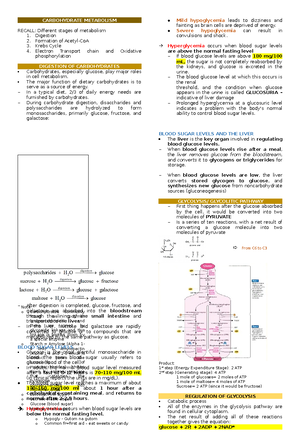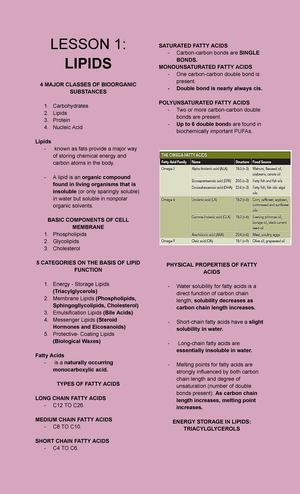- Information
- AI Chat
This is a Premium Document. Some documents on Studocu are Premium. Upgrade to Premium to unlock it.
Was this document helpful?
This is a Premium Document. Some documents on Studocu are Premium. Upgrade to Premium to unlock it.
Carbohydrate Metabolism (Metabolic Pathways)
Course: BIOCHEMISTRY (CHM3)
365 Documents
Students shared 365 documents in this course
University: Our Lady of Fatima University
Was this document helpful?
This is a preview
Do you want full access? Go Premium and unlock all 11 pages
Access to all documents
Get Unlimited Downloads
Improve your grades
Already Premium?

CHEM123
WEEK 17
CARBOHYDRATE METABOLISM
DIGESTION AND ABSORPTION OF
CARBOHYDRATES
Digestion is the biochemical process by which food
molecules, through hydrolysis, are broken down into
simpler chemical units that can be used by cells for
their metabolic needs.
- *First stage in processing food products
- *Only small amount of CHO is digested in the
mouth because the food is quickly swallowed to
the stomach
- *There’s no carbohydrate digestive enzyme
present on the stomach so there is really no
changes/effect. The salivary amylase is
inactivated in the stomach because of the
stomach acidity.
- *The primary site for carbohydrate digestion is
the small intestine. Pancreatic a-amylase is the
digestive enzyme present and can also be
found in the mouth.
- *Final step happens on the outer intestinal
mucosal cells that has different enzymes that
could break down disaccharides; maltase,
sucrase, lactase.
- *The monosaccharides are being absorbed in
the intestinal lining or intestinal villi.
Transported monosaccharides will go to the
bloodstream
-
- 8There are protein carriers and STP hydrolysis
that can mediate the passage of
monosaccharide units in the cell membrane.
- *Glucose can be utilized by the cells once
transported through the bloodstream
- *Galactose and fructose are converted in the
liver to become glucose
GLYCOLYSIS
Glycolysis is the metabolic pathway by which
glucose (a C6 molecule) is converted into two
molecules of pyruvate (a C3 molecule), chemical
energy in the form of ATP is produced, and NADH-
reduced coenzymes are produced
- *First metabolic pathway
- *Oxidation process, but there is no molecular
oxygen present; NAD as oxidizing agent
- *It is a 10-step process where each step is
enzyme-catalyzed. It has two stages based on
the number of carbon in molecules involved in
the process.
•
Anaerobic
pathways- metabolic pathways in
which molecular oxygen is not a participant
•
Aerobic
pathways- pathways that require
molecular oxygen
Six-Carbon Stage of Glycolysis (Steps 1–3)
- *The six-carbon stage of glycolysis is known to
be energy-consuming, which means that it
utilizes energy. The energy used is the ATP.
- *This is where the phosphate derivatives
glucose and fructose, which means that
glucose and fructose are coupled by an ATP.
The phosphate that will bond the two will be
from the ATP.
-
Why is this page out of focus?
This is a Premium document. Become Premium to read the whole document.
Why is this page out of focus?
This is a Premium document. Become Premium to read the whole document.
Why is this page out of focus?
This is a Premium document. Become Premium to read the whole document.




